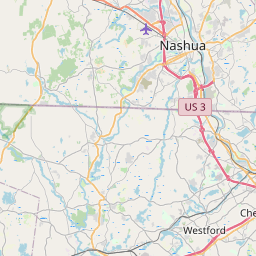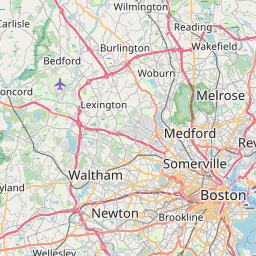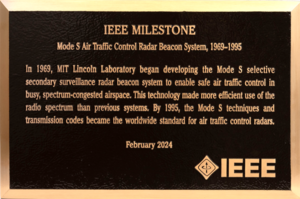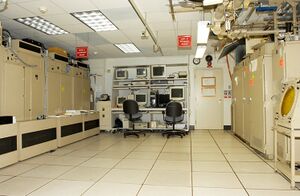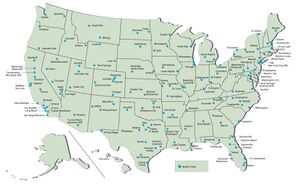Milestones:Mode S Air Traffic Control Radar Beacon System, 1969-1995

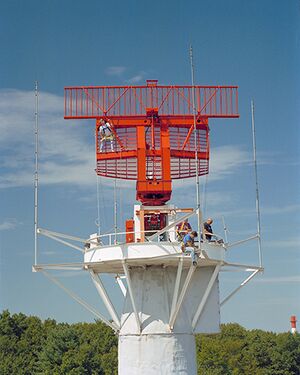
Title
Mode S Air Traffic Control Radar Beacon System, 1969-1995
Citation
In 1969, MIT Lincoln Laboratory began developing the Mode S selective secondary surveillance radar beacon system to enable safe air traffic control in busy, spectrum-congested airspace. This technology made more efficient use of the radio spectrum than previous systems. By 1995, the Mode S techniques and transmission codes became the worldwide standard for air traffic control radars.
Street address(es) and GPS coordinates of the Milestone Plaque Sites
MIT Lincoln Laboratory: 244 Wood St., Lexington, MA 02421 US (42.458626, -71.263568)
- Site entrance gate is on Wood St. at Schilling Circle
- Plaque location: Main Lobby (42.45913, -71.26700)
Details of the physical location of the plaque
One of 6 Milestone plaques on a display board prominently located in the Main Lobby
How the plaque site is protected/secured
Building security is next to the display board; viewable during normal business hours
Historical significance of the work
The original Air Traffic Control Radar Beacon System (ATCRBS) was in widespread use across the Air Traffic Control system. However, by the late 1960s, the rapid growth in aviation necessitated the development of a spectrum-efficient technical solution to accommodate reliable aircraft surveillance in regions with high traffic densities. The Mode S design introduced the selective interrogation of addressable transponders, a datalink between the cockpit and ground systems, and improved azimuth, altitude, and range resolution. An expansive, backward compatible design and prototype was developed for both the radar system and the avionics units. This work was performed at MIT Lincoln Laboratory and demonstrated at the Mode S Experimental System in Lexington Massachusetts. Eventually this design was adopted as an international standard and deployed at the major airports throughout the world.
Obstacles (technical, political, geographic) that needed to be overcome
The then state of the art was ATCRBS operating on 1030 MHz uplink and 1090 MHz downlink. This prior radar beacon system needed up to 16 replies as the radar beam swept the target in order to support sliding window beamsplitting to obtain an estimate of the target’s azimuth and resulted in a high level of replies from surrounding interrogators that interfered with the reception of the aircraft transponder replies at the local interrogator. ATCRBS also used broadcast interrogations so that every aircraft in the antenna beam replied. The replies from aircraft within 2 nm slant range of each other resulted in overlapping replies at the receiver, making them difficult to detect. This situation was especially serious when the radar systems were providing surveillance on aircraft in a holding stack.
In 1969, the Air Traffic Control Advisory Committee (ATCAC) predicted saturation of the ATCRBS reply frequency resulting from anticipated traffic growth. The committee recommended ATCRBS be upgraded with a new beacon system. The Federal Aviation Administration (FAA) tasked Lincoln Laboratory to develop such a system and an associated transponder.
Features that set this work apart from similar achievements
The MIT Lincoln Laboratory design included the following capabilities:
Monopulse azimuth measurements, using sum and difference beams, enabling:
- Lower interrogation rates to reduce reply channel loading and transponder occupancy
- Improved reply detection using monopulse for correlation
- Improved azimuth accuracy
- Monopulse to be applied to Mode S and ATCRBS surveillance
Mode S to operate transparently on 1030, 1090 MHz
- Mode S interrogations (to Mode S transponders) are not detected by ATCRBS transponders.
- Mode S transponders reply to ATCRBS interrogations from ATCRBS interrogators but not from Mode S interrogators.
Discrete addressing of Mode S transponders, including
- An acquisition method for new targets, followed by addressed interrogations
- Efficient scheduling of discrete interrogations, and immediate retries if necessary
- Parity protection and error correction for Mode S signals
- Integral datalink, with 56 or 112 bits per message
- Pulse position modulation of the Mode S reply to provide the same number of pulses for monopulse, independent of the message content
Top and bottom transponder antennas to mitigate banking fades
Significant references
Vincent A. Orlando., “The Mode S Radar Beacon System”, MIT Lincoln Laboratory Journal, Volume 2, Number 3, 1989. Media:Mode_S_Radar_Beacon_System_Lincoln_Journal_Vol_2_Number_3.pdf
Edward M. Hofstetter and Darrol F. Delong, Jr., “Detection and Parameter Estimation in an Amplitude-Comparison Monopulse Radar”, IEEE Transactions on Information Theory, Vol. IT-15, No. 1, January 1969. Media:Detection and Parameter Estimation in an Amplitude-Comparison Monopulse Radar.pdf
D. A. Shnidman, “A Comparison of Immunity to Garbling for Three Candidate Modulation Schemes for DABS”, MIT Lincoln Laboratory, Project Report ATC-12, 14 August 1972, FAA-RD-72-84. Media:Shnidman_1972_ATC-12_WW-15318.pdf
P. R. Drouilhet, “Provisional Signal Formats for the Discrete Address Beacon System”, MIT Lincoln Laboratory Project Report ATC-30.1, 25 April 1974, FAA-RD-74-62. Media:Drouilhet_1974_ATC-30i_WW-15318.pdf
J. -C. Sureau, “A Summary of DABS Antenna Studies”, MIT Lincoln Laboratory, Project Report ATC-53, 3 February 1976, FAA-RD-75-112. Media:Summary of DABS antenna studies-1.pdf
T. J. Goblick, "DABS Modulation and Coding Design", MIT Lincoln Laboratory Project Report ATC-52, 12 March 1976, FAA-RD-75-93. Media:Goblick_1976_ATC-52_WW-15318.pdf
R. J. McAuley and V. Vitto, “A Simulation of the DABS Sensor for Evaluating Reply Processor Performance”, MIT Lincoln Laboratory, Project Report ATC-28, 16 September 1974, FAA-RD-74-123. Media:Mcaulay_1974_ATC-28_WW-15318.pdf
International Civil Aviation Organization, “International Standards and Recommended Practices, Annex 10 to the Convention on Civil Aviation, Aeronautical Telecommunications, Volume IV Surveillance and Collision Avoidance Systems”, Fifth Edition, Annex 10, Volume 4, July 2014. Media:International Standards and Recommended Practices, Surveillance and Collision Avoidance Systems, Annex 10, Volume 4.pdf
Supporting materials
See references
Dedication Ceremony
Map
